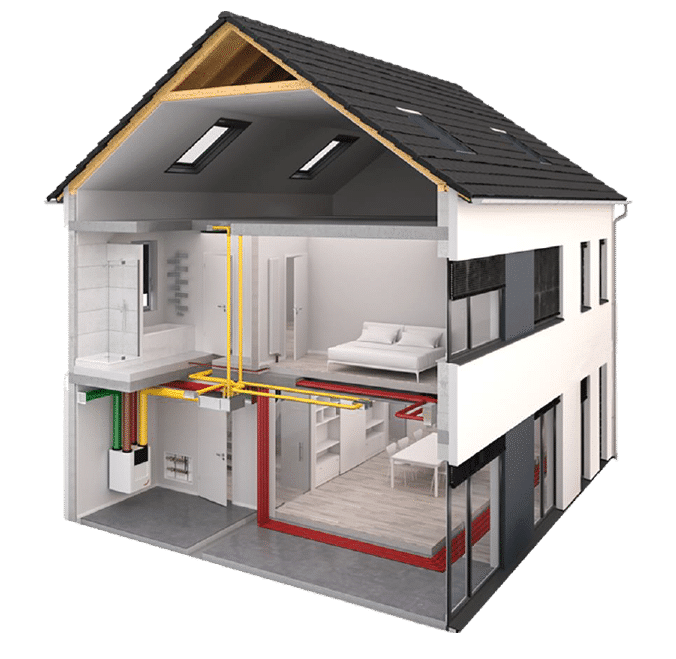Exploring HRV: A Step-by-Step Introduction
Wiki Article
The All-Inclusive Overview to the Uses of Heat Recovery Ventilation in Modern Structures
Heat Recovery Ventilation (HRV) systems stand for a considerable development in developing modern technology (HRV Heat Recovery Ventilation). They supply a method for trading stagnant indoor air with fresh exterior air while minimizing energy loss. This method not just boosts interior air high quality but additionally adds to power effectiveness in both household and commercial structures. Recognizing the different applications and benefits of HRV can disclose its essential duty in modern-day style and sustainability efforts. The implications of this innovation deserve exploring furtherUnderstanding Heat Recovery Ventilation Solutions

Many modern-day buildings focus on power performance, comprehending warmth recovery air flow (HRV) systems is important for maximizing indoor air quality and decreasing power consumption. HRV systems function by transferring heat from stale interior air to incoming fresh air, effectively maintaining comfortable interior temperature levels while decreasing energy loss. These systems include a warmth exchanger, followers, and ductwork that promote the circulation of air. Throughout winter, HRV devices catch and reuse warm from the outgoing air, while in summer season, they can help cool down incoming air. By constantly trading air, HRV systems also reduce humidity and the concentration of indoor toxins. Correct setup and maintenance of HRV systems are important for their performance and efficiency in improving total structure performance and convenience.
Benefits of Heat Recovery Ventilation
Heat recovery ventilation systems offer various advantages that boost both energy efficiency and interior air top quality in modern structures. By capturing and reusing energy from exhaust air, these systems substantially decrease heating & cooling expenses, leading to reduced power intake. Furthermore, they preserve a stable circulation of fresh outside air, reducing the risk of indoor air pollutants and allergens. This continuous exchange assists regulate humidity levels, preventing mold development and guaranteeing a healthier living atmosphere. In addition, HRV systems add to sustainability goals by decreasing overall carbon impacts. Their ability to maximize air flow without giving up thermal comfort makes them a beneficial enhancement to modern building layout, advertising both financial and environmental benefits.Applications of HRV in Residential Structures
As property owners increasingly prioritize power efficiency and interior air high quality, the applications of warm healing ventilation (HRV) systems in domestic buildings have actually become more widespread. HRV systems are especially valuable in snugly sealed homes, where maintaining fresh air blood circulation is important for stopping dampness buildup and interior pollutants. They properly transfer heat from outbound stagnant air to inbound fresh air, reducing energy expenses connected with heating and cooling. In addition, HRVs can enhance comfort levels by controling moisture and temperature. They are also versatile go to these guys for various domestic designs, consisting of single-family homes and multi-unit structures. In general, integrating HRV systems sustains sustainable living techniques while ensuring a much healthier indoor environment for owners.HRV in Commercial and Commercial Setups
In commercial and industrial settings, the execution of warm recuperation air flow (HRV) systems has actually ended up being increasingly vital for maximizing energy efficiency and keeping air top quality. These systems properly move warm from exhaust air to inbound fresh air, decreasing the demand for added heating or cooling. This not just decreases power prices yet click site also adds to sustainability campaigns. Industries such as manufacturing, warehousing, and workplace structures benefit substantially from HRV systems, as they assist manage temperature and moisture levels, ensuring a comfortable and efficient setting. Furthermore, HRV systems help in removing impurities and excess dampness, improving interior air high quality. As policies around air quality become more stringent, the fostering of HRV modern technology is most likely to expand, making it an essential component of modern industrial and commercial facilities.Future Trends in Heat Recovery Ventilation Modern Technology

Frequently Asked Concerns
Just How Does Heat Recovery Ventilation Effect Indoor Air High Quality?
Heat recovery ventilation significantly improves indoor air quality by continually exchanging stagnant interior air with fresh outside air while recuperating energy. This procedure minimizes contaminants, preserves ideal moisture degrees, and assures a much healthier environment for occupants.Can HRV Systems Be Installed in Existing Buildings?
HRV systems can indeed be mounted in existing buildings. Retrofitting may require adjustments to ductwork and ventilation formats, yet it substantially improves power efficiency and indoor air top quality, making it a viable choice for older frameworks.What Upkeep Is Needed for HRV Systems?

Are There Particular Climates Where HRV Is More Efficient?
Heat recovery ventilation systems are especially efficient in climates with substantial temperature level distinctions between seasons. These systems optimize power effectiveness by recovering warmth from exhaust air, making them perfect for both chilly and reasonably warm settings.How Do HRV Equipments Affect Power Expenses?

Report this wiki page